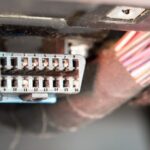The Autophix OBD2 code reader is a valuable tool for diagnosing car problems. Understanding how to use it can save you time and money on repairs. This guide provides comprehensive instructions on using your Autophix OBD2 code reader, from connecting it to your vehicle to interpreting the results.
Understanding OBD2 and DTCs
On-Board Diagnostics II (OBD2) is a standardized system that monitors your vehicle’s engine and emissions control systems. When a problem is detected, the system stores a Diagnostic Trouble Code (DTC) in the vehicle’s computer. Your Autophix OBD2 code reader retrieves these codes, providing insight into potential issues. A DTC is a five-digit alphanumeric code. The first character indicates the system (e.g., Powertrain, Body, Chassis), while the remaining digits specify the specific problem.
Connecting Your Autophix OBD2 Code Reader
- Locate the DLC: The Data Link Connector (DLC) is a 16-pin port usually located under the dashboard on the driver’s side. Consult your vehicle’s owner’s manual if you can’t find it.
- Turn on the Ignition: Turn the ignition key to the “on” position without starting the engine. This powers up the OBD2 system.
- Connect the Reader: Plug the Autophix OBD2 code reader’s connector into the DLC. Ensure a secure connection.
- Power on the Reader: The device will typically power on automatically.
Reading and Interpreting Codes
- Read Codes: Navigate to the “Read Codes” function on your Autophix device. The reader will retrieve any stored DTCs.
- Interpreting Codes: Use the code definitions provided in the device’s manual or look them up online. Each code corresponds to a specific problem.
- Example: Code P0420 might indicate a problem with the catalytic converter.
Additional Features of the Autophix OBD2 Code Reader
Beyond reading codes, most Autophix readers offer additional features:
- Erase Codes: After repairs, use this function to clear the DTCs.
- Live Data: View real-time sensor data, such as engine RPM, coolant temperature, and oxygen sensor readings. This data can help diagnose issues and monitor vehicle performance.
- Freeze Frame Data: Captures vehicle data at the moment a fault code was set, providing context for the problem.
- I/M Readiness: Checks if the vehicle’s emission monitors are ready for a smog test.
Conclusion
The Autophix OBD2 code reader is a powerful tool that empowers car owners to understand and address vehicle issues. By following these instructions, you can confidently use your reader to diagnose problems, save money, and maintain your car’s health. Remember to always consult your vehicle’s repair manual for specific diagnostic procedures. Using an OBD2 code reader is the first step in troubleshooting; further diagnosis may be required to pinpoint the exact cause of a problem.

